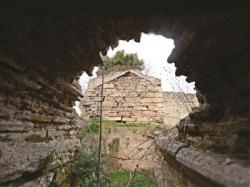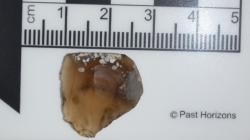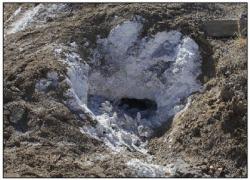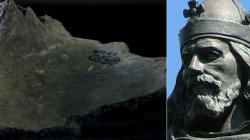INSTITUT SUPERIEUR D'ANTHROPOLOGIE
INSTITUTE OF ANTHROPOLOGY
ONLINE COURSES / COURS A DISTANCE
SPRING TERM : APRIL 2014
REGISTER NOW
TURQUIE –  Bursa - Archaeological excavations that have been carried out in the northwestern province of Bursa have discovered 2,300-year-old dungeons used for execution and torturing during the Bithynia Kingdom era. Archaeologists discovered that the dungeons, which contain a “bloody well,” “torture chamber” and “corridors connected to tower,” used horrific execution methods. Uludağ University Faculty of Science and Literature History of Art Department member İbrahim Yılmaz, who was on the excavation team, said within the scope of the project to reveal Bursa city walls, implemented by the Bursa Municipality, the restoration of centuries-old walls were continuing. Yılmaz said a large part of the 3,400-meter-long walls had been revealed and the locations of “Taht-ı Kale,” “Yer Kapı,” “Saltanat Kapısı,” “Kaplıca Kapı” and “Zindan Kapı,” which are around the city walls and provide entrance to the walls, had also been determined. Restoration in the Zindan Kapı in Alacahırka neighborhood, which is located in the last part of the walls, discovered dungeons, Yılmaz said. “Over these dungeons were houses were people were living. Considering that there were dungeons or dungeon remains might be there, we expropriated these buildings. After the houses were demolished, scientific excavations revealed remains of Bursa dungeons,” he said. He said all spatial features of dungeons in the era of the Bithynia Kingdom could be seen in those dungeons. He said the Bursa dungeons were the underground structures named “stucco” and connected to towers, and continued:“These dungeons here include a ‘bloody well,’ ‘torture chamber’ and ‘corridors connected to tower’. There are also walls connected to the tower and dungeon chambers. Hangmen, who were deaf and mute, cut off the heads of prisoners here in the bloody well. While the head of the body was falling into the well, the body part was given to their relatives or left to the stream. There are also rumors that hangmen were selling dead bodies to families for a price. We discovered all of these things, proposed a project and it was approved. We will start construction here in the coming days.”
Bursa - Archaeological excavations that have been carried out in the northwestern province of Bursa have discovered 2,300-year-old dungeons used for execution and torturing during the Bithynia Kingdom era. Archaeologists discovered that the dungeons, which contain a “bloody well,” “torture chamber” and “corridors connected to tower,” used horrific execution methods. Uludağ University Faculty of Science and Literature History of Art Department member İbrahim Yılmaz, who was on the excavation team, said within the scope of the project to reveal Bursa city walls, implemented by the Bursa Municipality, the restoration of centuries-old walls were continuing. Yılmaz said a large part of the 3,400-meter-long walls had been revealed and the locations of “Taht-ı Kale,” “Yer Kapı,” “Saltanat Kapısı,” “Kaplıca Kapı” and “Zindan Kapı,” which are around the city walls and provide entrance to the walls, had also been determined. Restoration in the Zindan Kapı in Alacahırka neighborhood, which is located in the last part of the walls, discovered dungeons, Yılmaz said. “Over these dungeons were houses were people were living. Considering that there were dungeons or dungeon remains might be there, we expropriated these buildings. After the houses were demolished, scientific excavations revealed remains of Bursa dungeons,” he said. He said all spatial features of dungeons in the era of the Bithynia Kingdom could be seen in those dungeons. He said the Bursa dungeons were the underground structures named “stucco” and connected to towers, and continued:“These dungeons here include a ‘bloody well,’ ‘torture chamber’ and ‘corridors connected to tower’. There are also walls connected to the tower and dungeon chambers. Hangmen, who were deaf and mute, cut off the heads of prisoners here in the bloody well. While the head of the body was falling into the well, the body part was given to their relatives or left to the stream. There are also rumors that hangmen were selling dead bodies to families for a price. We discovered all of these things, proposed a project and it was approved. We will start construction here in the coming days.”
http://www.hurriyetdailynews.com/archaeologists-discover-ancient-death-chambers-used-for-execution-torture-in-bursa.aspx?pageID=238&nID=61192&NewsCatID=375
ROYAUME UNI –  Telford -A piece of ancient flint unearthed by volunteers during an archaeological dig in Telford Town Park last year has been confirmed as being from the late Mesolitic/early Neolithic age.The discovery of the piece of core trimming flake – which mostly likely formed some kind of tool – has been hailed as “significant” by archaeologists that have evaluated the find. It probably dates back to approximately 10,000 BC.No confirmed prehistoric artefacts with a secure providence have previously been found in the Telford area. The flint is damaged, most likely from agricultural activity, but is unlikely to have travelled too far. One flake is not conclusive proof of prehistoric activity in the area but it does prove that earlier archaeological remains can survive in places associated with large scale industrial centres.
Telford -A piece of ancient flint unearthed by volunteers during an archaeological dig in Telford Town Park last year has been confirmed as being from the late Mesolitic/early Neolithic age.The discovery of the piece of core trimming flake – which mostly likely formed some kind of tool – has been hailed as “significant” by archaeologists that have evaluated the find. It probably dates back to approximately 10,000 BC.No confirmed prehistoric artefacts with a secure providence have previously been found in the Telford area. The flint is damaged, most likely from agricultural activity, but is unlikely to have travelled too far. One flake is not conclusive proof of prehistoric activity in the area but it does prove that earlier archaeological remains can survive in places associated with large scale industrial centres.
http://www.shropshirelive.com/2014/01/17/telford-dig-discovery-confirmed-as-prehistoric-flint/
NORVEGE – Laerdal - Officials say a large fire has blazed through a historical village famous for its well-preserved wooden houses from the 18th and 19th centuries, destroying at least 23 buildings.
http://www.hurriyetdailynews.com/fire-ruins-parts-of-historical-village-in-norway.aspx?pageID=238&nID=61265&NewsCatID=375
INDE –  Bhubaneswar - Archaeologists and conservationists have slammed the conservation being carried out by the state archaeology department at the Lakhmaneswar group of temples opposite Rameswar temple at Mausima Square. The critics have alleged that the renovation has significantly deviated from the original architecture of the temple that belongs to 7th century.The temple group, consisting of Lakhmaneswar, Bharateswar and Satrughneswar temples, are all situated in the same complex. B.P. Ray, superintending archaeologist of the state archaeology department, said: “We are renovating the Lakhmaneswar temple after a careful study of the other two temples — Bharateswar and Satrughneswar — in the same complex. We study the measurements according to Shilpa Sashtra, or the ancient temple-building principles of the Kalinga era.”
Bhubaneswar - Archaeologists and conservationists have slammed the conservation being carried out by the state archaeology department at the Lakhmaneswar group of temples opposite Rameswar temple at Mausima Square. The critics have alleged that the renovation has significantly deviated from the original architecture of the temple that belongs to 7th century.The temple group, consisting of Lakhmaneswar, Bharateswar and Satrughneswar temples, are all situated in the same complex. B.P. Ray, superintending archaeologist of the state archaeology department, said: “We are renovating the Lakhmaneswar temple after a careful study of the other two temples — Bharateswar and Satrughneswar — in the same complex. We study the measurements according to Shilpa Sashtra, or the ancient temple-building principles of the Kalinga era.”
http://www.telegraphindia.com/1140119/jsp/frontpage/story_17777627.jsp#.UtwCZRBKGM8
USA –  Verde - Salt has been a valuable trade item throughout human history. Native American salt procurement in the Southwest involved dangerous journeys across sacred landscapes associated with a deity called Salt Woman. This presentation describes the famous salt mine in Camp Verde where prehistoric tools used for mining salt were discovered in the 1920s by historic miners. These tools were located deep inside tunnels dug into a thick, fresh-water salt deposit by Sinagua miners.
Verde - Salt has been a valuable trade item throughout human history. Native American salt procurement in the Southwest involved dangerous journeys across sacred landscapes associated with a deity called Salt Woman. This presentation describes the famous salt mine in Camp Verde where prehistoric tools used for mining salt were discovered in the 1920s by historic miners. These tools were located deep inside tunnels dug into a thick, fresh-water salt deposit by Sinagua miners.
http://www.dcourier.com/main.asp?SectionID=1&SubSectionID=1&ArticleID=127475
ROYAUME UNI –  Winchester - The bones of King Alfred the Great or his son, Edward the Elder, are believed to have been found in a box stored at Winchester City Museum .Archaeologists carried out an exhumation of the grave at St Bartholomew's Church in Winchester last March in a bid to find the last resting place of the ninth-century king.Tests shown that those remains were not the influential warrior king but further investigations have uncovered a pelvis bone which had been in storage at Winchester City Museum from a previous excavation carried out at the end of the 1990s.Carbon dating has shown that this bone dates back to 895-1017, which scientists from the University of Winchester believe ties in with the death of the two kings and is unlikely to have come from anyone apart from the father or the son.Dr Katie Tucker, researcher in human osteology at the University of Winchester, said she had been disappointed when the exhumed bones turned out to be much later than Alfred's time - the earliest of six partial skeletons found dated back to about 1100 - but said the subsequent find was an "amazing'' discovery.According to historical records, when King Alfred died in 899, he was interred at the Anglo-Saxon cathedral in Winchester, known as the Old Minster, and his bones were later moved by monks to New Minster and then Hyde Abbey, still in Winchester.Hyde Abbey was dismantled after the dissolution of the monasteries in the 16th century and the bodies buried on the site are believed to have been "scattered'' when a prison workhouse was built there in 1788.It was during a community excavation in the late 1990s that the pelvic bone believed to be Alfred's or Edward's was found.But no analysis of the find was undertaken because of lack of funding and because a bone found next to it was found to be from the 17th or 18th century and it was not thought to be of any interest.
Winchester - The bones of King Alfred the Great or his son, Edward the Elder, are believed to have been found in a box stored at Winchester City Museum .Archaeologists carried out an exhumation of the grave at St Bartholomew's Church in Winchester last March in a bid to find the last resting place of the ninth-century king.Tests shown that those remains were not the influential warrior king but further investigations have uncovered a pelvis bone which had been in storage at Winchester City Museum from a previous excavation carried out at the end of the 1990s.Carbon dating has shown that this bone dates back to 895-1017, which scientists from the University of Winchester believe ties in with the death of the two kings and is unlikely to have come from anyone apart from the father or the son.Dr Katie Tucker, researcher in human osteology at the University of Winchester, said she had been disappointed when the exhumed bones turned out to be much later than Alfred's time - the earliest of six partial skeletons found dated back to about 1100 - but said the subsequent find was an "amazing'' discovery.According to historical records, when King Alfred died in 899, he was interred at the Anglo-Saxon cathedral in Winchester, known as the Old Minster, and his bones were later moved by monks to New Minster and then Hyde Abbey, still in Winchester.Hyde Abbey was dismantled after the dissolution of the monasteries in the 16th century and the bodies buried on the site are believed to have been "scattered'' when a prison workhouse was built there in 1788.It was during a community excavation in the late 1990s that the pelvic bone believed to be Alfred's or Edward's was found.But no analysis of the find was undertaken because of lack of funding and because a bone found next to it was found to be from the 17th or 18th century and it was not thought to be of any interest.
http://www.heart.co.uk/southcoast/news/local/king-alfred-new-piece-of-evidence-winchester/
ROYAUME UNI -  Rushton - The remains of four Anglo-Saxon adults have been found in shallow graves during excavation work at a river in Northamptonshire. The graves, 12in (30cm) below ground level, were found during the work to create a new backwater at the River Ise at Rushton near Kettering. A 6th Century bowl was also found in the graves. Archaeologists said they were "excited" by the graves, which have since been covered again with soil.Jim Brown, senior project officer at Northamptonshire Archaeology, said the discovery of burial goods with the body remains indicated the people were "certainly pagan". "The 6th Century date... suggests we're looking at settlers - people who have come here to establish a small farmstead on very good agricultural land," he said. "They would have been subsisting at a small agricultural level."
Rushton - The remains of four Anglo-Saxon adults have been found in shallow graves during excavation work at a river in Northamptonshire. The graves, 12in (30cm) below ground level, were found during the work to create a new backwater at the River Ise at Rushton near Kettering. A 6th Century bowl was also found in the graves. Archaeologists said they were "excited" by the graves, which have since been covered again with soil.Jim Brown, senior project officer at Northamptonshire Archaeology, said the discovery of burial goods with the body remains indicated the people were "certainly pagan". "The 6th Century date... suggests we're looking at settlers - people who have come here to establish a small farmstead on very good agricultural land," he said. "They would have been subsisting at a small agricultural level."
http://www.bbc.co.uk/news/uk-england-northamptonshire-25774172